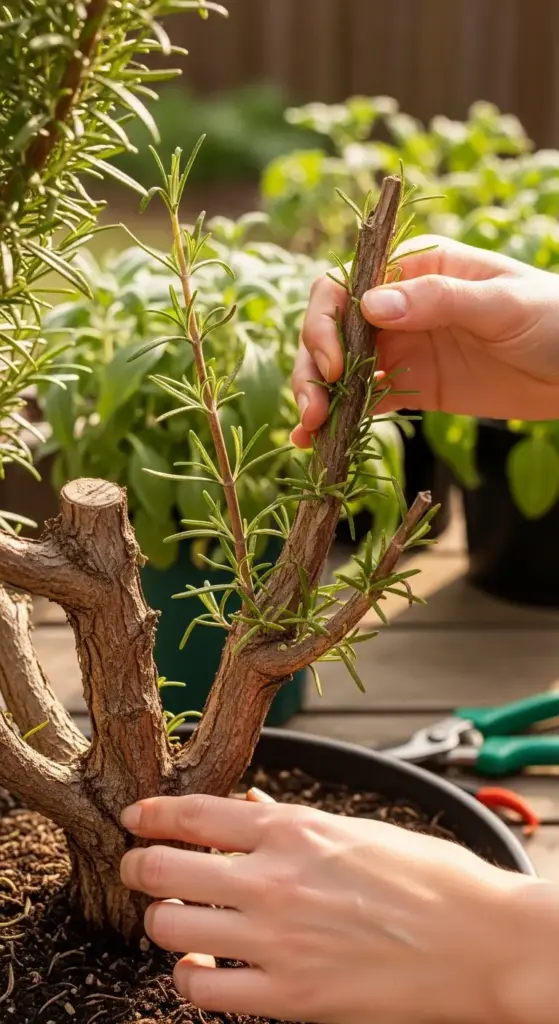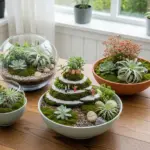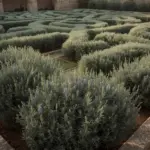2. Woody Stems That Won’t Produce New Growth

I’ll never forget staring at my three-year-old rosemary plant, wondering why it looked more like a tiny dead tree than the lush herb I’d dreamed of. Those woody stems were thick and brown, and no matter how much I watered or fertilized, nothing green was happening.
Turns out, I’d been making the classic beginner mistake of treating my rosemary like it was supposed to stay soft and green forever.
Understanding Rosemary’s Natural Growth Patterns
Here’s what nobody tells you about rosemary growth patterns – this plant is basically trying to become a shrub, whether you like it or not. In its natural Mediterranean habitat, rosemary grows into these gorgeous woody bushes that can live for decades.
The problem is, most of us want that fresh, tender growth for cooking. And woody stems? They’re tough as nails and taste about as good as chewing on a pencil.
Healthy rosemary plants develop woody stems as they mature – it’s totally normal. But here’s the key: those woody parts should still be producing new green shoots from the tips and sides.
I learned this after watching my neighbor’s gorgeous rosemary bush. The base was completely woody, but it was covered in fresh green growth sprouting from every branch.
Signs Your Plant Has Become Too Woody and Unproductive
My first clue that something was wrong? No new growth for three months straight. The woody stems just sat there looking stubborn and lifeless.
Here are the warning signs I wish I’d caught earlier: stems that are completely brown and hard with no green tips, branches that haven’t produced any new leaves in over a month, and that telltale sign – when you gently scratch the bark with your fingernail, there’s no green underneath.
Unproductive rosemary also tends to have stems that are thicker than a pencil with no side shoots. It’s like the plant put all its energy into building this woody fortress and forgot it was supposed to make leaves.
The smell test works too. Fresh rosemary stems should release that amazing aroma when you brush against them. Woody, unproductive stems barely smell like anything.
The Pruning Mistake That Kills Most Rosemary Plants
Oh boy, this one still makes me cringe. I thought I was being helpful by cutting my rosemary way back – like, really way back. We’re talking down to just the woody stems with no green left anywhere.
Big mistake. Huge.
Here’s what I didn’t know: rosemary can’t regenerate from old woody growth the way some plants can. If you cut below the green growth into just the brown woody part, that branch is basically dead to you.
The pruning rule I follow now is simple – never cut more than one-third of the plant at once, and always leave some green growth on every branch you’re cutting.
I killed two perfectly good rosemary plants learning this lesson the hard way.
Best Times of Year to Rejuvenate Woody Growth
Timing is everything with rosemary pruning, and I learned this after butchering a plant in the middle of winter. Poor thing never recovered.
Spring pruning is your best bet – right after the last frost when the plant is gearing up for its growing season. I usually aim for late March or early April, depending on where I’m living.
Summer pruning can work too, but only light trimming. Never do major cuts when it’s blazing hot outside.
Fall pruning? Don’t even think about it. The plant needs all its energy to get through winter, not to heal from major cuts.
I’ve had the best luck with rejuvenation pruning in early spring. That’s when I’ll take out up to one-third of the oldest, woodiest stems completely, cutting them back to where they meet younger growth.
Tools Every Home Gardener Needs for Proper Rosemary Maintenance
You don’t need fancy equipment, but having the right pruning tools makes all the difference. I used to use kitchen scissors (don’t judge me), and the results were… not pretty.
Sharp bypass pruners are essential – I’m talking about the kind that cut like scissors, not the anvil type that crush stems. Crushing damages the plant and invites disease.
A small pair of snips for harvesting is also clutch. I keep mine in the kitchen drawer so I can grab fresh rosemary without trekking to the shed for the big pruners.
For really woody stems, sometimes you need loppers – basically big pruners with long handles. But honestly, if your rosemary needs loppers, you might have waited too long.
Keep everything clean too. I wipe my blades with rubbing alcohol between plants. Sounds paranoid, but plant diseases spread faster than gossip.
One tool I didn’t expect to need? A small hand rake for clearing out dead growth from the center of the plant. All those little twigs and leaves that fall off get trapped inside, and they can harbor pests and diseases.
Think you’ve got the pruning thing figured out? Click “next” to discover the sneaky white coating that might already be spreading across your rosemary leaves – and why catching it early could save your entire herb garden!









GIPHY App Key not set. Please check settings